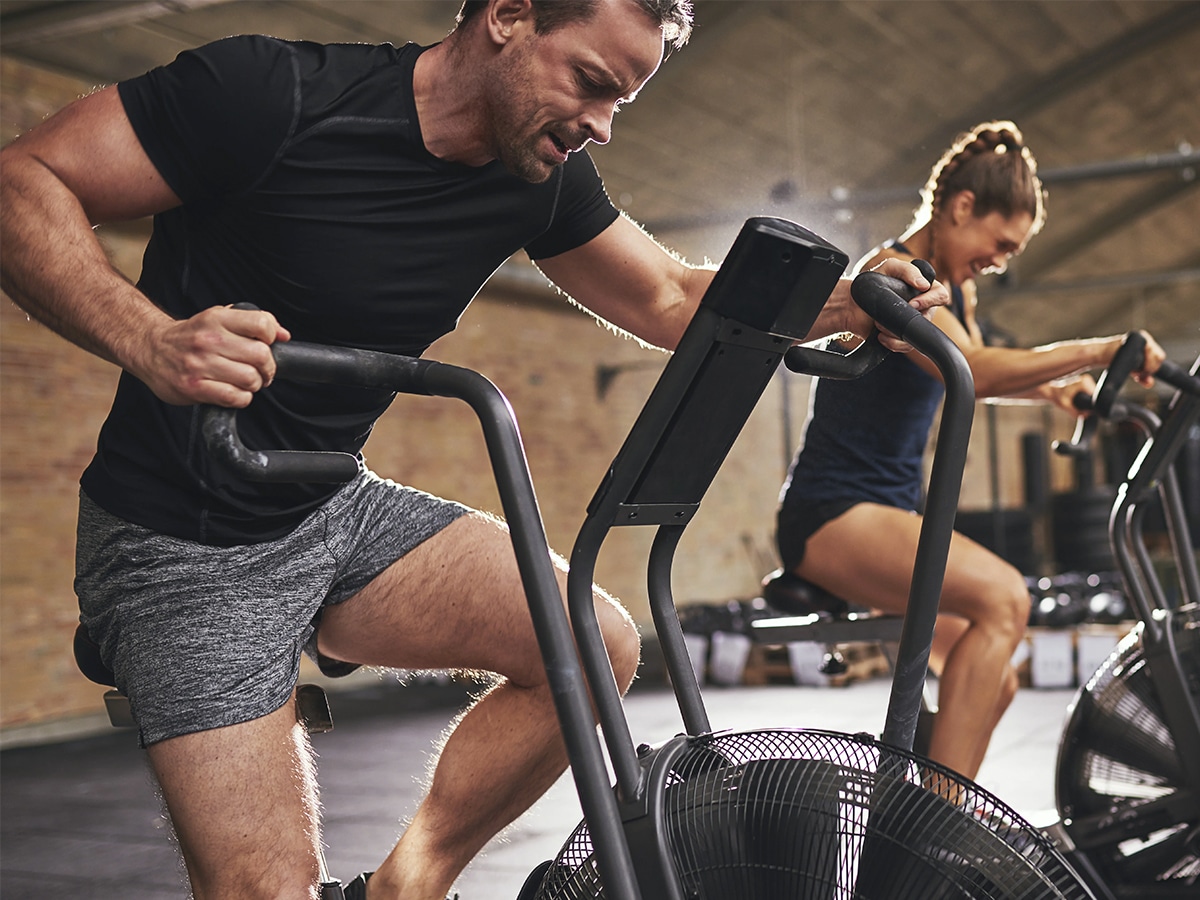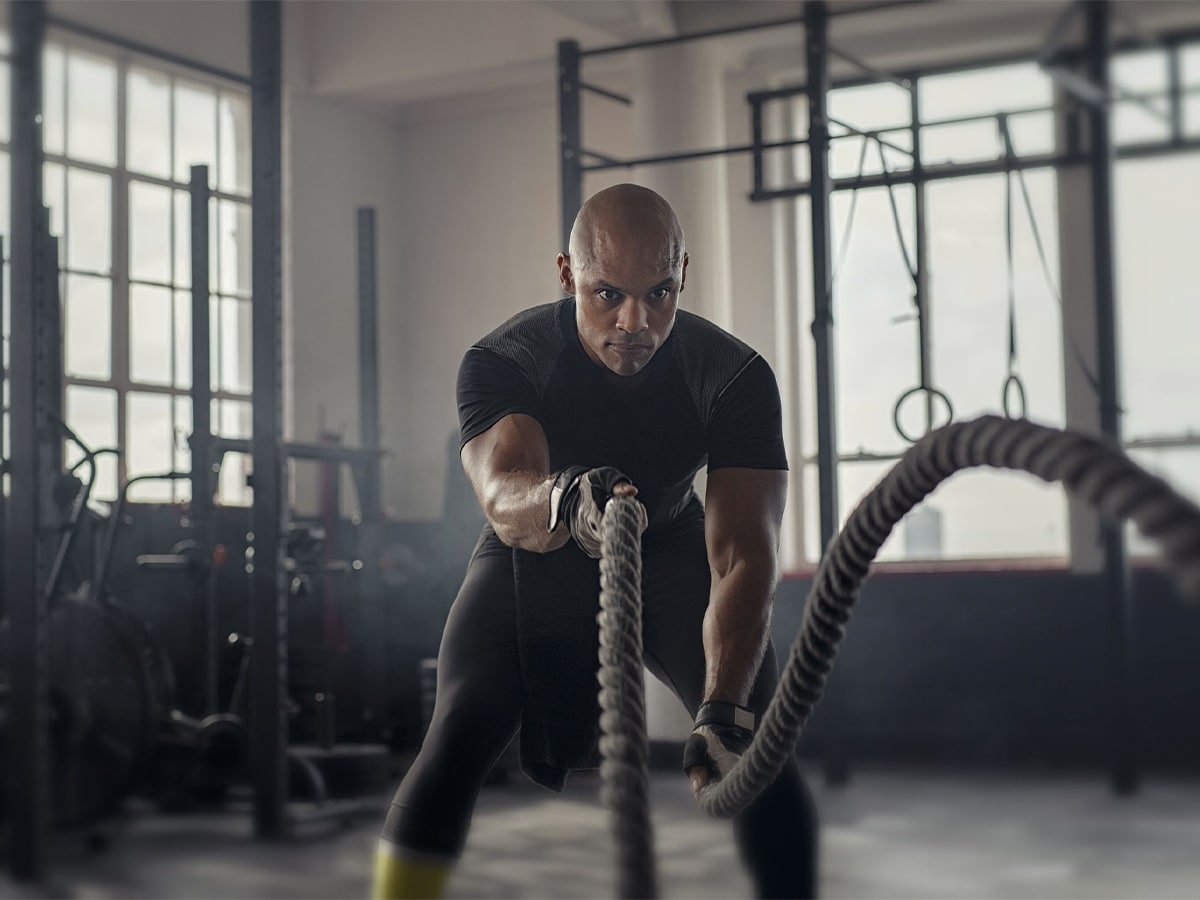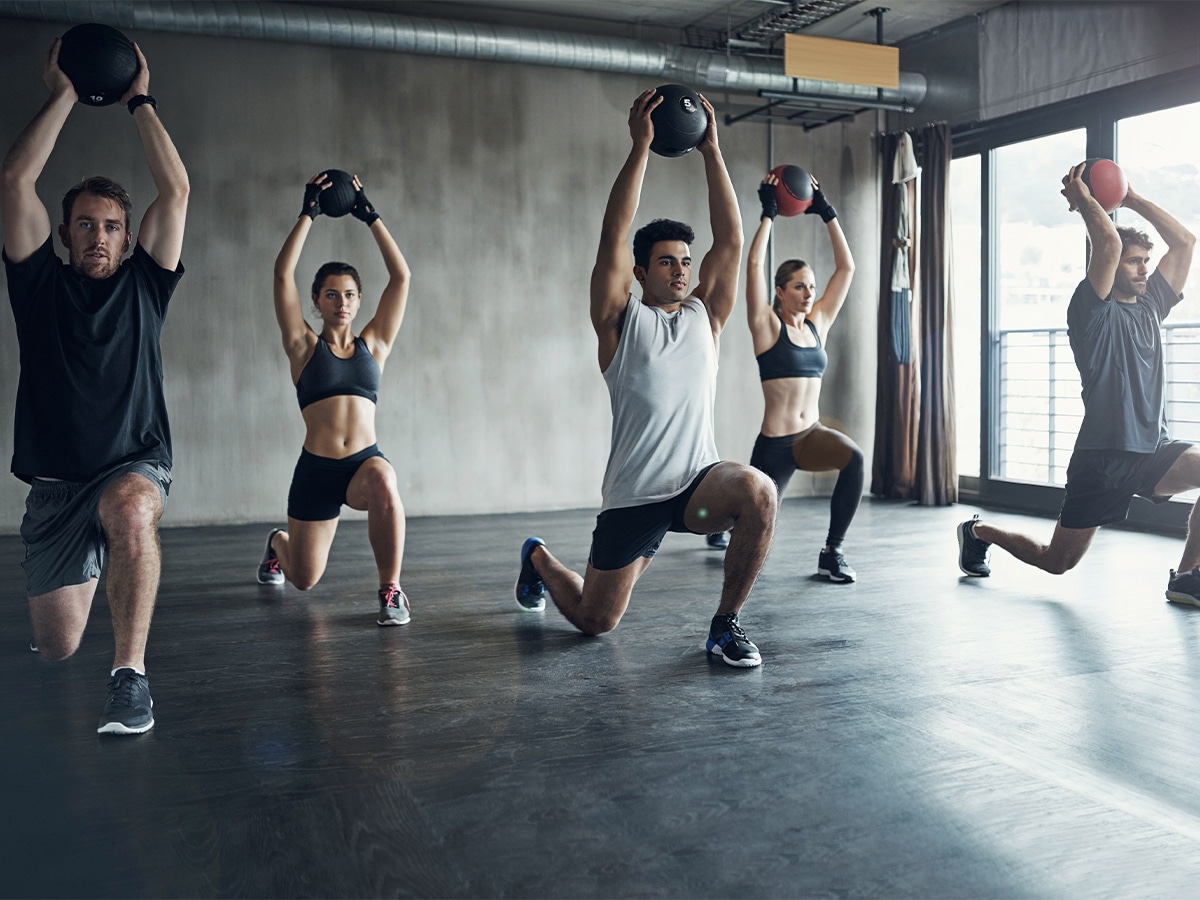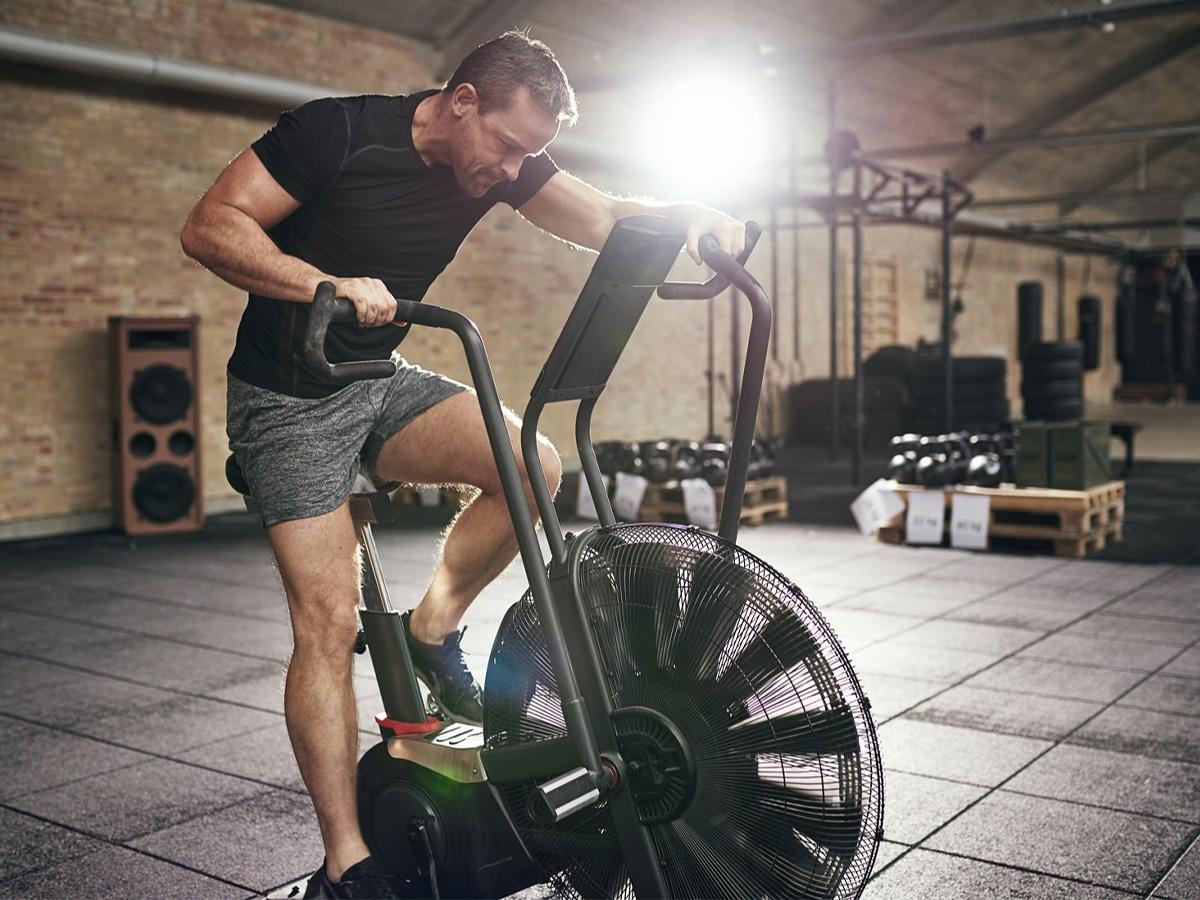
Published:
Readtime: 13 min
Every product is carefully selected by our editors and experts. If you buy from a link, we may earn a commission. Learn more. For more information on how we test products, click here.
If you’re looking for the best HIIT exercises for men, you’ve come to the right place. Forget spending hours in the gym attempting to perform hours of solid-state cardio and doing a million crunches, it doesn’t have to be that hard. In fact, if marathon-length runs and Herculean efforts in the gym aren’t doing the trick, chances are you not making the most of fitness evolution. You need to get into HIIT.
You’ll also like:
How to Lose Weight Fast & Maximise Your Workout

Best HIIT Workouts
Understanding what makes the best HIIT workout effective comes down to the protocol involved in the workout. While the majority of researched HIIT workouts are based on cardiovascular exercises, it’s important to note that you can alternate these movements to target whatever muscle groups you want to focus on. The best HIIT exercises are those that incorporate an element of resistance training whilst getting your heart rate up. For example;
- Push-ups
- Sit-ups
- Lunges
- Crunches
- Jumping jacks
- High knees
- Cable chops
- Squat
- Squat and press
- Overhead press
- Chest press
- Sprints
You can switch these exercises out to make your own workouts based on the protocols listed below. Here is a list of the 11 best HIIT workouts for men.
1. 4 x 4 Interval Training
Recommended by the Norwegian University of Science and Technology, the 4 x 4 Interval Training HIIT workout is best implemented on a seven-week program. This 4X4 routine requires the participant to go at high intensity for four minutes usually around 85-95 per cent of maximum heart rate, followed by three minutes of active recovery at 60 per cent of maximum heart rate. To complete the 4 x 4 interval training workout;
- Warm-up (10-minute moderate jog)
- Interval 1 (1-2 minute sprint at 85-95% max heart rate)
- Active break (3 minutes lower intensity moderate jogging)
- Cool-down (5-minute moderate jogging)
This formula could easily be replicated to incorporate any exercise, however, for this example, the base model is running.
Interval: 1-2 minutes/3 minutes rest
Rounds: 1-3
2. Tabata Protocol
Created by Izumi Tabata, the Tabata Protocol is one of the best workout methods to incorporate into your fitness routine. It only takes eight minutes (give or take) every three days, so this is a creating method system to add for beginners. The Tabata Protocol is best performed with Stationary Bike, Versaclimber, Rowing Machine, Elliptical Trainer or another piece of cardio equipment that allows for gradually increasing resistance, speed and utilises the large muscles of your legs. To complete a Tabata Protocol HIIT workout;
- Warm-up for 2 minutes at a moderate pace, before initiating 2 intervals.
- First, increase the tension one notch above where your warmup ended.
- Pedal at 100 per cent effort for 20 seconds.
- Pedal slow for the next 10 seconds as a recovery. If you are wearing a heart rate monitor, you will see your Heart Rate go up after you stop pedalling. This is because of the Oxygen Debt created signals your body to get more oxygen to your energy system.
- Repeat the full process 1 more time.
- After 2 intervals, decrease the tension to 0 and pedal slow for 2 minutes.
Do this workout three times per week – allow yourself at least one full day of recovery between workouts. Your body needs to heal itself, increase the strength of your heart and lungs, etc.
Interval: 20 seconds/10 seconds rest
Rounds: 4
3. The 30s Blast
To make this training protocol work, you must complete 3-5 rounds through the circuit, resting for 30-60 seconds between rounds. Try to avoid resting between moves, making sure you get the most out of your high-intensity points. To complete the 30s blast;
- Tuck Jump Plank Tucks x 30 seconds
- Plyo Jack Push-Ups x 30 seconds per side
- Single Leg Deadlift Hops x 30 seconds
- Plank Skaters x 30 seconds
- Balance Bicycles x 30 seconds
- 30-60 seconds Rest
Interval: 30 seconds/60 seconds rest
Rounds: 4
4. The 20/20 Full-Body Cardio HIIT Workout
This variation of the HIIT workout comes by way of Cori Lefkowith from Redefining Strength. In order to get the most out of this workout, you need to complete 4-6 rounds through the circuit, working for 20 seconds, resting for 20 seconds as you transition to the next move. Then rest 20-40 seconds between rounds. For the Single Leg Deadlift Hops, alternate sides each round. To complete the 20/20 full-body cardio HIIT workout;
- Tuck Jump Plank Tucks x 20 seconds
- Rest x 20 seconds
- Plyo Jack Push-Ups x 20 seconds
- Rest x 20 seconds
- Single-Leg Deadlift Hops x 20 seconds
- Rest x 20 seconds
- Plank Skaters x 20 seconds
- Rest x 20 seconds
- Balance Bicycles x 20 seconds
- Rest x 20-40 seconds
Interval: 20 seconds/20 seconds rest
Rounds: 4
5. Sprint Interval HIIT Workout
The most basic form of HIIT exercise is the sprint interval workout. This method sees you progressively build your sprints over a sustained period with little rest to increase your endurance and health. To perform a sprint interval HIIT workout on a treadmill;
- After warming up, sprint at 100 per cent effort for 35 seconds.
- Rest for 25 seconds
- Repeat for 10 rounds
Interval: 35 seconds/25 seconds rest
Rounds: 10
6. Burpee Interval HIIT Workout
The burpee, while dreaded by most is one of the best HIIT exercises you can complete. The full-body exercise engages your core and builds your cardiovascular health throughout the workout. This is another style of workout that utilises AMRAP (As Many Rep As Possible in the allotted time period) To complete the burpee interval HIIT workout;
- Perform pull-ups AMRAP for 30 seconds
- Rest for 15 seconds
- Perform jumping jacks AMRAP for 30 seconds
- Rest for 15 seconds
- Perform 20 burpees
- Rest for 30 seconds
- Complete full circuit 4 times
Interval: 30 seconds/15 seconds rest
Rounds: 4
7. Jump Rope Interval HIIT Workout
Another HIIT workout that makes uses of cardiovascular based training, this circuit involves some basic movements you might not have done for a while. A favourite of boxers and combat fighters, the jump rope interval workout is great for overall health. To complete the jump rope interval HIIT workout;
- Perform mountain climbers x 45
- Perform push-ups x 45
- Perform plank for 1 minute
- Perform jump rope for 1 minute
- Rest for 1 minute
- Complete full circuit 4 times
Interval: 45 reps/1 minute rest
Rounds: 4
8. Lower Body HIIT Workout
If you want to target those lower leg muscles and burn some calories at the same time, the lower body HIIT workout is your ideal fix. This mix strength/cardiovascular circuit has all the elements of a great bodyweight workout, with the added benefit of being super simple. To complete the lower body HIIT workout;
- Sprint for 30 seconds
- Perform squat jumps AMRAP f0r 30 seconds
- Perform lunges x 20 each leg
- Perform calf raises x 50
- Perform jumping lunges AMRAP for 30 seconds
- Rest for 1 minute
- Complete full circuit three times
Interval: 30 seconds/1 minute rest
Rounds: 3
9. Abdominal HIIT Exercises
If you’ve ever done an abdominal finisher to complete a workout, you might be surprised to know that you’ve already been diving into one of the best HIIT workouts out there. The high-intensity circuit is ideal for core strength and building mobility. Here is how to complete the abdominal HIIT exercises;
- Perform crunches x 50
- Rest for 15 seconds
- Perform bicycle crunches AMRAP for 30 seconds
- Rest for 15 seconds
- Perform situps x 15
- Rest for 15 seconds
- Perform leg raises x 20
- Rest for 15 seconds
- Perform butterfly kicks x 50
- Rest for 1 minute
- Complete full circuit three times
Interval: 30 seconds/15 seconds rest
Rounds: 3
10. Battle Ropes HIIT Workout
One of the most feared apparatus in the gym, the battle ropes are the ultimate HIIT exercise addition. You can put the rope around a stable, immovable object like a pole, goal post or concrete pillar to make the process easy. For this battle ropes HIIT workout, you’ll need to grasp the ropes in both hands. Half of the total reps will be with a double arm motion; half will be with alternating arm motion.
- Perform double-arm battle rope slams AMRAP for 30 seconds
- Rest for 15 seconds
- Perform alternating-arm battle rope slams AMRAP for 30 seconds
- Rest for 1 minute
- Complete full circuit ten times
Interval: 30 seconds/15 seconds rest
Rounds: 10
11. Strength Training HIIT Workout
While most of these HIIT workouts focus on cardiovascular-based exercises, this is one that will help get the blood flowing and muscles working in a resistance setting. This form of strength training aims to boost your full body health, across major muscle groups. To perform a strength training HIIT workout;
- Holding a light dumbbell in each hand, bring arms up so elbows are bent, palms are facing down and perform alternative-arm punches AMRAP for 45 seconds
- Rest for 15 seconds
- Sprint on treadmill AMRAP for 45 seconds
- Rest for 15 seconds
- Holding a light dumbbell in each hand, perform alternating single-leg lunges AMRAP for 45 seconds
- Rest for 15 seconds
- Holding a light dumbbell in each hand, perform a squat. At the top of the movement, press the two dummbeels overhead, locking arms at full length.
- Rest for 1 minute
- Complete full circuit 4 times
Interval: 45 seconds/15 seconds rest
Rounds: 4

What is HIIT?
When done right, HIIT workouts can be some of the most effective fitness routines you can have in your arsenal, but what exactly is HIIT and how does it work?
HIIT stands for high-intensity interval training, a form of training that is characterised by short bursts of intense exercise alternated with low-intensity recovery periods that make up the protocol. HIIT is super quick and employs a series of easy-to-establish work-to-rest ratios. This, in turn, makes HIIT workouts arguably the most time-efficient form of full-body exercise, particularly when it comes to weight loss. But this isn’t anything new.
Runners have used interval training for over a century, alternating between sprints and jogging to improve their overall performance, but it wasn’t until the New York Times’ infamous ‘Seven Minute Workout‘ that high-intensity interval training reached the mainstream. Often blending aerobic and resistance training, HIIT workouts achieve regular bouts of sustained effort to build endurance and strength. The basic premise of a HIIT workout will see you perform alternate hard-charging intervals, during which a person’s heart rate reaches at least 80 percent of its maximum capacity usually for one to five minutes, with periods of rest or less intense exercise.
In the mid-90s, Japanese doctor Izumi Tabata and a team of colleagues developed the Tabata protocol. This structure generally involved a high-intensity period of 20 seconds followed by 10 seconds of rest, completed for eight rounds. The exercises include movements such as;
- Push-ups
- Bodyweight lunges
- Turkish get-ups
- Pikes
To summarise, High-Intensity Interval Training (HIIT) is one of the most popular fitness innovations of the 21st century, made famous through big-name gyms and group fitness chains such as F45 and OrangeTheory. The ultra-challenging mix of cardiovascular and strength training allows you to burn calories quickly and for a sustained period.

How Do HIIT Exercises Work?
The key to making HIIT exercises work for you is ensuring you maintain a high-level of intensity throughout your ‘on’ periods. You simply can’t coast through the work periods of your workout, you really need to go hard. One way to incorporate HIIT exercises into your workout regime is to build a full workout around HIIT or alternatively, you can add supersets to create a targeted finisher.
While you need to go hard in order to truly get the benefits of HIIT, it’s important to exercise within reason. If you are a complete novice at the movement, it pays to be cautious. Rather than completing 15 to 30-second intervals executed at near-100 per cent intensity, aim for intervals of one to three minutes at closer to 80 per cent of maximum effort, followed by up to five minutes of lower intensity exercise.
In group fitness settings HIIT and ‘interval training’ are often used interchangeably, but this is not always the case. HIIT requires explosive performance, while basic interval training utilises work periods that are typically larger than rest periods. However, you do it, what makes HIIT work is the intensity. You’re going to go as hard as you can for a short period of time, then resting for a length of time that’ll let you recover to go hard once again.

Benefits of HIIT
There are a number of reasons you might want to get stuck into the best HIIT workout you can find, but for the most part, it’s efficiency. HIIT workouts have been proven to burn calories and sustain muscle mass over an extended period, often in a shorter timeframe. Here are the key benefits of HIIT;
Fat Loss
The primary reason people turn to HIIT exercises is fat loss, and for good reason. A study from the Norwegian University of Science and Technology found that doing high-intensity training three times a week for 12 weeks reduces cardiovascular disease, improves vascular functions and lowers body fat.
In fact, one study found that people performing HIIT three times per week for 20 minutes per session lost 2 kgs, of body fat in 12 weeks — without any dietary changes. Even more important, participants found a 17 per cent reduction in visceral fat, or the disease-promoting fat surrounding your internal organs.
Metabolic Rate
This is a term you may have heard but never used before, however, it plays an important role in your overall health. Put simply, HIIT workouts are effective because they allow you to burn calories long after the workout has finished. Certain studies suggest that HIIT can elevate your metabolism for hours after exercise. This results in additional calories being burned even after you have finished exercising.
Shortened Workouts
Ever feel like you just don’t have time for a full workout? That’s where the best HIIT workouts can come in handy. A recent study from the National Center for Biotechnology Information found that HIIT burned 25–30 per cent more calories than the other forms of exercise, such as isolated strength training or cardiovascular endurance training. With more efficient workouts now achievable, you don’t have to spend hours in the g
You’ll also like:
14 Best Dumbbell Workouts and Exercises For a Full-Body Workout
27 Best Oblique Exercises for Men
11 Must-Do Ab Exercises You Can Do at Home
10 Best Chest Exercises for Men
General FAQs
The best HIIT exercises are ones that elevate your heart rate, whilst maximising your anaerobic endurance. These include tuck jumps, battle ropes, sprints and jumping lunges.
Short bursts of intense exercise have proven to be effective for weight loss than longer less intense workouts. The elevated heart rate allows your body to continually burn calories long after the workout has ended.
HIIT is a great, safe, and effective workout that can be replicated every day without injury. That being said, there is no real need to perform a HIIT workout every day unless you are training for a specific event.































Comments
We love hearing from you. or to leave a comment.